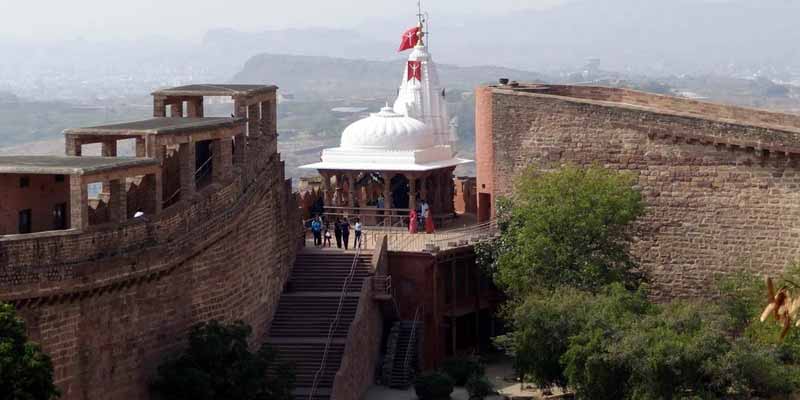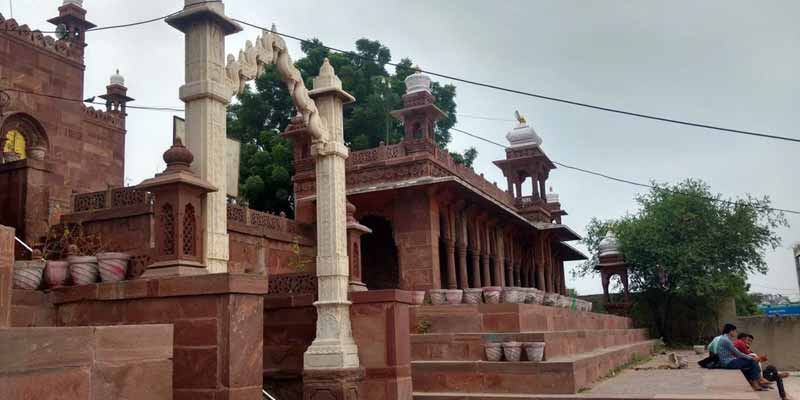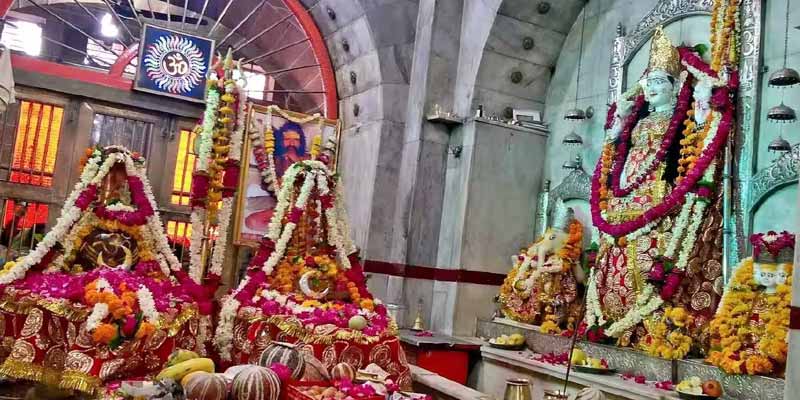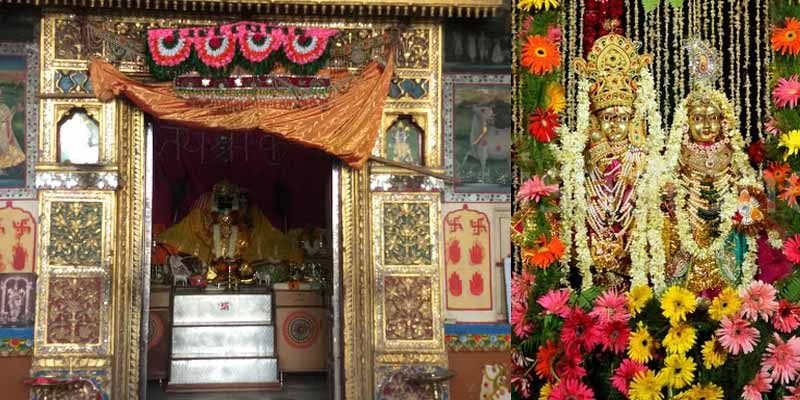7 Most Famous Temples in Jodhpur, the Blue City of Rajasthan, is not only famous for its majestic forts and palaces but also for its ancient and serene temples. Among these, the Chamunda Mata Temple stands out prominently. Located within the Mehrangarh Fort complex, it is dedicated to Chamunda Mataji, the goddess of war and the patron deity of the royal family. The temple offers stunning views of the city and is a significant site of worship during festivals like Navratri.
Another significant temple is the Raj Ranchhodji Temple, adorned with intricate stained glass windows and detailed gold filigree work. Devoted to Lord Krishna, this temple reflects the artistic traditions of Jodhpur and is a serene retreat for pilgrims and visitors alike.
The Achal Nath Shivalaya is another notable temple in Jodhpur. Built in 1531 by Nanak Devi, the queen of Rao Ganga, this temple is dedicated to Lord Shiva. Its key features include a large water reservoir called Bawari, which was used for religious purposes, and beautiful architecture that captures the essence of the era.
These temples not only offer spiritual solace but also give insights into the rich cultural tapestry of Jodhpur.

Chamunda Mata Temple:
Chamunda Mata Temple, situated atop the mighty Mehrangarh Fort in Jodhpur, Rajasthan, holds immense religious significance and offers breathtaking panoramic views of the blue city. The temple is dedicated to Chamunda Mataji, the revered Hindu deity and patron goddess of the Rathore rulers, the founders of Jodhpur. Legend has it that Rao Jodha, the founder of Jodhpur, brought the idol of the goddess from the old capital of Mandore in 1460 to ensure the prosperity and protection of his new city.
The temple’s architecture blends seamlessly with the fort, featuring intricate carvings and traditional Rajasthani designs. Its location inside one of India’s largest forts adds to its historical and architectural charm. Devotees from across the country flock to this temple, especially during the festivals of Dussehra and Navratri, when the temple is spectacularly decorated and rituals are performed with great fervor.
Visitors to Chamunda Mata Temple can also explore the other attractions within Mehrangarh Fort, including its museums and galleries that showcase royal palanquins, costumes, and armaments. The journey to the temple itself is a spiritual ascent, passing through ancient gateways and walls that resonate with centuries of history. This sacred site not only offers spiritual solace but also connects visitors with the cultural heritage of Rajasthan.

Raj Ranchhodji Temple:
Raj Ranchhodji Temple, located in the heart of Jodhpur, Rajasthan, is an architectural marvel and a spiritual sanctuary dedicated to Lord Krishna. Built by Queen Jadechi Rajkanwar after the death of her husband, Maharaja Jaswant Singh II, in the late 19th century, the temple stands as a testament to both devotion and Rajputana architectural style.
The temple is renowned for its intricate carvings and exquisite workmanship. The walls and ceilings are adorned with finely detailed frescoes and Rajasthani motifs, which narrate tales from the life of Lord Krishna. These decorations reflect the traditional craftsmanship that Rajasthan is famous for, and they are particularly notable for their vibrancy and attention to detail.
One of the temple’s most distinctive features is its use of red sandstone, which is typical of many historic structures in Jodhpur. This gives the temple a majestic aura, aligning perfectly with the rugged beauty of the surrounding landscape. The temple also houses an idol of Lord Krishna, which is revered by the devotees. It is made of rare black marble and is adorned with elaborate garments and ornaments, making it a focal point for worshippers.
Raj Ranchhodji Temple is not just a place of worship but also a cultural hub, representing the spiritual and artistic heritage of Jodhpur. It attracts tourists and devotees alike, who come to admire its beauty and soak in the serene spiritual atmosphere it offers.

Achal Nath Shivalaya:
Achal Nath Shivalaya is a revered ancient temple dedicated to Lord Shiva, located in Jodhpur, Rajasthan, India. Constructed in 1531 by Nanak Devi, the queen of Rao Ganga, the temple stands as a remarkable example of medieval Indian architecture and religious devotion. The temple complex is renowned for its intricate carvings and splendid architectural elements that reflect the artistry of the period.
The centerpiece of the temple is the Garbh Griha, where the sacred Shiva lingam is enshrined, symbolizing the presence of Lord Shiva. Surrounding the sanctum are various halls and courtyards, each adorned with beautiful sculptures and motifs that enhance the spiritual atmosphere of the site. Notably, the temple features a large water reservoir called Bawari, which was used for religious rituals and daily use by the priests.
Achal Nath Shivalaya is not just a place of worship but also a site of cultural heritage that attracts devotees and tourists alike. The temple’s serene environment offers a peaceful retreat from the bustling city life of Jodhpur. Throughout the year, the temple hosts numerous festivals and ceremonies, with Maha Shivratri being the most prominent, drawing thousands of devotees who come to offer their prayers and seek blessings.

Kunj Bihari Temple:
The Kunj Bihari Temple in Jodhpur, Rajasthan, is a revered Hindu temple dedicated to Lord Krishna, also known as Kunj Bihari. Situated amidst the bustling lanes of the old city, this temple is not only a place of worship but also a significant cultural and architectural landmark.
The temple’s architecture showcases intricate carvings and vibrant paintings, reflecting the rich heritage of Rajasthan. Visitors are greeted with a serene atmosphere as they step into the temple complex, adorned with colorful flags and ornate decorations.
Devotees flock to the Kunj Bihari Temple to seek blessings, offer prayers, and immerse themselves in the spiritual ambiance. The temple resonates with the melodious chants of hymns and the rhythmic beats of traditional instruments during religious ceremonies and festivals, such as Janmashtami, the birth anniversary of Lord Krishna.
Moreover, the temple serves as a center for various cultural activities, including music and dance performances, further enriching the spiritual and artistic tapestry of Jodhpur.
Overall, the Kunj Bihari Temple stands as a symbol of devotion, architectural brilliance, and cultural vibrancy, drawing both locals and tourists alike to experience its divine aura and historical significance.
Siddhanath Shiv Temple:
The Siddhanath Shiv Temple in Jodhpur, Rajasthan, is a revered site steeped in history and spirituality. Dedicated to Lord Shiva, this ancient temple holds significant religious importance for Hindus and attracts devotees and tourists alike.
Situated atop a hill, the temple offers panoramic views of the surrounding landscape, adding to its allure. Its architecture reflects traditional Rajasthani style, characterized by intricately carved stone work and exquisite craftsmanship.
Legend has it that the temple was built by King Siddha of the Rathore clan, hence the name Siddhanath. According to local belief, worshipping at this temple fulfills desires and grants blessings from Lord Shiva.
Devotees throng to the temple, especially during festivals like Mahashivratri, to offer prayers and seek divine blessings. The serene atmosphere and spiritual ambience make it a place for introspection and contemplation.
Visiting Siddhanath Shiv Temple provides not just a religious experience but also an opportunity to admire the architectural marvels of ancient India while immersing oneself in the rich cultural heritage of Rajasthan.
Rasik Bihari Temple:
The Rasik Bihari Temple in Jodhpur is a significant religious site revered by devotees of Lord Krishna. Located in the heart of the city, this temple stands as a testament to the vibrant spiritual culture of Rajasthan.
Constructed in the traditional Rajasthani architectural style, the temple’s intricate carvings and vibrant colors mesmerize visitors. Its central deity, Lord Krishna, is worshipped with great devotion by locals and tourists alike. The temple complex encompasses not only the main shrine but also various smaller shrines dedicated to different gods and goddesses, creating a serene ambiance for prayer and meditation.
Throughout the year, the temple hosts various religious festivals and ceremonies, with Janmashtami, the birth anniversary of Lord Krishna, being the most grandly celebrated. During these festivities, the temple comes alive with devotional songs, dances, and elaborate decorations, attracting pilgrims from far and wide.
Beyond its religious significance, the Rasik Bihari Temple also serves as a cultural hub, promoting art, music, and spirituality. Its tranquil surroundings offer a peaceful retreat from the hustle and bustle of city life, inviting visitors to immerse themselves in divine bliss and serenity.
Baba Ramdev Temple:
The Baba Ramdev Temple in Jodhpur, Rajasthan, stands as a testament to the enduring reverence for the legendary saint Baba Ramdev. Located near the Mehrangarh Fort, this temple holds a significant place in the hearts of devotees who flock here seeking blessings and solace.
Constructed in his honor, the temple exudes a sense of serenity and spirituality, with its intricate architecture and vibrant surroundings. Devotees often gather here to pay homage to Baba Ramdev, known for his selfless devotion and miraculous deeds.
Legend has it that Baba Ramdev possessed divine powers and dedicated his life to serving the people, particularly the downtrodden and those in need. His teachings of compassion, righteousness, and service continue to inspire millions across the country.
Visitors to the temple can experience a profound sense of peace and spirituality as they offer prayers and seek blessings. The aura of devotion and faith pervades the atmosphere, making it a sacred sanctuary for devotees from far and wide.
The Baba Ramdev Temple in Jodhpur not only serves as a place of worship but also as a symbol of the enduring legacy of a saint whose teachings transcend time and continue to guide generations towards a path of righteousness and compassion.
India Tour Planner








